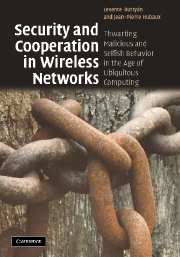 Security and Cooperation in Wireless Networks
Security and Cooperation in Wireless Networks Book contents
- Frontmatter
- Contents
- Preface
- Acknowledgements
- Part I Introduction
- Part II Thwarting malicious behavior
- Part III Thwarting selfish behavior
- 9 Selfish behavior at the MAC layer of CSMA/CA
- 10 Selfishness in packet forwarding
- 11 Wireless operators in a shared spectrum
- 12 Secure protocols for behavior enforcement
- Appendix A Introduction to cryptographic algorithms and protocols
- Appendix B A tutorial on game theory for wireless networks
- References
- Index
12 - Secure protocols for behavior enforcement
from Part III - Thwarting selfish behavior
Published online by Cambridge University Press: 05 June 2012
- Frontmatter
- Contents
- Preface
- Acknowledgements
- Part I Introduction
- Part II Thwarting malicious behavior
- Part III Thwarting selfish behavior
- 9 Selfish behavior at the MAC layer of CSMA/CA
- 10 Selfishness in packet forwarding
- 11 Wireless operators in a shared spectrum
- 12 Secure protocols for behavior enforcement
- Appendix A Introduction to cryptographic algorithms and protocols
- Appendix B A tutorial on game theory for wireless networks
- References
- Index
Summary
So far, in Part III of the book, we have shown through examples (MAC layer, packet forwarding, and co-existence of wireless operators) how to model selfish behavior. We have also explained how it is possible to enforce a desirable behavior by observing other players' behavior. For this purpose, we have made extensive use of game theory. Yet, the security techniques that we have shown in Part II can also be of help in this framework; for example, authentication of the wireless nodes is necessary in order to thwart selfish behavior at the MAC layer.
In Chapter 3, we have explained that it is difficult to provide a fully satisfactory definition of malicious and selfish behavior, because the two notions are strongly intertwined. In this chapter, we will make a fundamental additional step and show how security and game theoretic techniques can be combined to thwart misbehavior in wireless networks.
In compliance with the other chapters of Part III, we will articulate our development around an example. As we have seen in Chapter 10, cooperation does not happen “naturally” for packet forwarding in self-organized ad hoc networks. This means that cooperation must be encouraged. There are several ways to achieve this goal. One of them consists in relying on micropayments.
- Type
- Chapter
- Information
- Security and Cooperation in Wireless NetworksThwarting Malicious and Selfish Behavior in the Age of Ubiquitous Computing, pp. 379 - 392Publisher: Cambridge University PressPrint publication year: 2007


